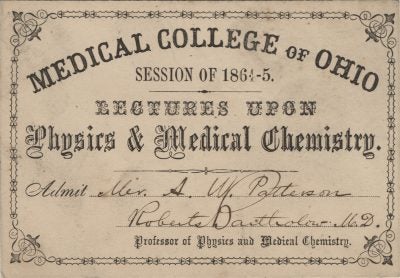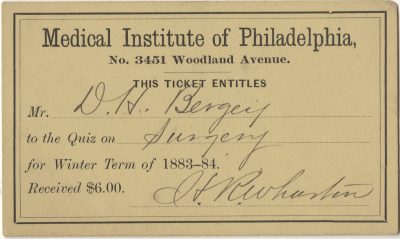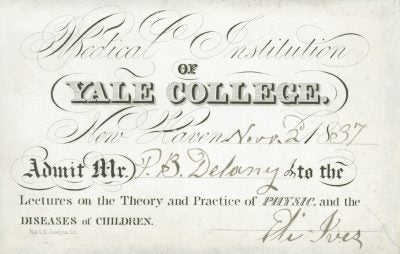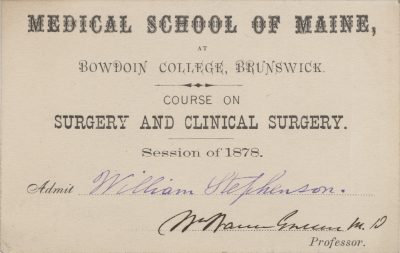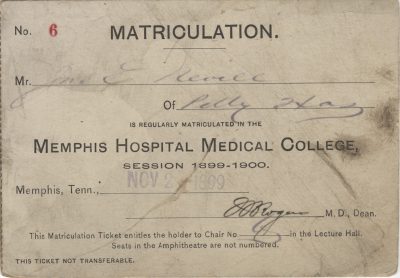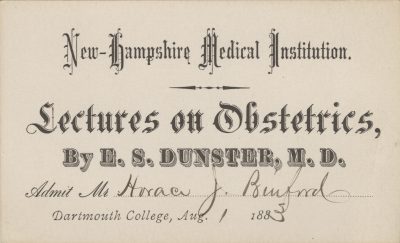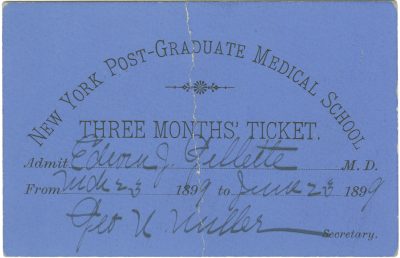35. Medical College of Ohio (University of Cincinnati College of Medicine)
| Medical College of Ohio (University of Cincinnati College of Medicine) 1864-65 Bartholow, Roberts, MD Patterson, Amos W. Physics and medical chemistry |
|
| In 1819 Daniel Drake (Penn; M1816) founded the Medical College of Ohio, the state’s first medical school. At that time, steamboat transportation was transforming Cincinnati into a thriving city. Cincinnati physicians, trained by local preceptors, resisted the idea of a school that would train competitors. Drake prevailed and became president of the new medical school, which merged with the University of Cincinnati in 1896. From 1864 to 1879 Bartholow (Maryland; M1852) taught physics and medical chemistry at the Medical College of Ohio. During this time he conducted his famous – or infamous – application of Faradic electrical currents to the exposed dura of a patient, noting what parts of the body responded to brain stimulation. This was the first demonstration of the motor excitability of the human cerebral cortex with the use of stimulating electrodes. Patterson (Ohio; M1866), an Indiana native, pursued a general practice in Indianapolis.
Harris, L.J. and J.B. Almerigi. “Probing the Human Brain with Stimulating Electrodes: the Story of Roberts Bartholow’s (1874) Experiment on Mary Rafferty.” Brain Cogn. 2009 Jun; 70(1):92-115. Epub 2009 Mar 14.
Norwood, William Frederick. Medical Education in the United States before the Civil War. Phila: University of Pennsylvania Press, 1944. 304-10. Pictorial and Biographical Memoirs, Indianapolis and Marion County. Indiana. Chicago: Goodspeed Brothers, 1893. 40. |
|
36. Medical Institute of Philadelphia
| Medical Institute of Philadelphia 1883-84 Wharton, H.R. (Henry Redwood), MD Bergey, David H. Surgery quiz |
|
|
Nathaniel Chapman, MD (Penn; M1801) (72) founded the Medical Institute of Philadelphia in 1817 to supplement practical and demonstrative instruction during the interval (April to October) between Penn’s standard winter sessions. The Institute did not confer diplomas. After 1852 the school’s schedule paralleled that of the city’s degree-granting medical schools, with most classes offered at day’s end. By the 1880s classes followed a progression from basic to clinical science. Lectures and quizzes comprised the teaching format. Penn appointed Wharton (Penn; M1876) instructor in clinical surgery in 1879 and demonstrator of surgery in 1885. He also served as assistant surgeon to the University Hospital and surgeon to the Children’s Presbyterian and Methodists Hospitals. A creditable educator, Wharton authored two handbooks of surgery, as well as textbook articles about pediatric tracheotomy. Bergey (Penn; M1884), who taught bacteriology in Penn’s Laboratory of Hygiene, authored the classic text, Bergey’s Manual of Determinative Bacteriology (1923), which classified bacteria based on their structural and functional attributes.
Hays, I. Minis, MD, editor. The American Journal of the Medical Sciences. Vol. 87. Phila: Henry C. Lea’s Son & Cok. April 1884. 42.
Smith, R.A. Philadelphia As It Is in 1852: Being a Correct Guide to All the Public Buildings; Literary, Scientific, and Benevolent Institutions; and Places of Amusement; Remarkable Objects; Manufactories; Commercial Warehouses; and Wholesale and Retail Stores in Philadelphia and Its Vicinity. Phila: Lindsay and Blakiston, 1852. 167,169. University of Pennsylvania Archives & Records Center. Alumni Records. Wharton, H.R., MD. “Tracheotomy.” Cyclopaedia of the Diseases of Children: Medical and Surgical. Vol. 2. Edited by John Marie Keating. Phila: J.B. Lippincott Company, 1890. 539-576. |
|
37. Medical Institution of Yale College (Yale School of Medicine)
| Medical Institution of Yale College (Yale School of Medicine) 1837-38 Ives, Eli, MD Delany, P. Benson, Jr. Theory and practice of physic and the diseases of children |
|
| The Medical Institution of Yale College, chartered in 1810, opened in 1813. Yale required higher standards of preliminary education for admission than did other medical schools, hurting enrollment when a boom in medical schools that started in the 1830s increased competition for students. Yale was also atypical in that it fixed the price of professors’ lecture tickets to be no more than $12.50. Ives studied with his father and attended lecture courses with Penn professors Rush (12), Wistar (13) and Barton (69), but did not complete the degree. The Connecticut Medical Society awarded him an honorary MD in 1811. Ives helped establish Yale’s medical school and was one of four original professors, teaching materia medica. He also delivered the nation’s first systematic pediatrics course and held the earliest American academic appointment in pediatrics. Delany (83) was fortunate to take this course during his interlude at Yale. In 1860 Ives was elected president of the American Medical Association.
Blumer, George. “Eli Ives – Practitioner, Teacher and Botanist.” Yale J Biol Med. 1932 May; 4(5): 649.b1-663.
Medicine at Yale, 1810-2010. Harvey Dushing/John Hay Whitney Medical Library, Medical Historical Library, Yale University. Norwood, William Frederick. Medical Education in the United States before the Civil War. Phila: University of Pennsylvania Press, 1944. 192-98. Pearson, Howard A. “Lectures on the Diseases of Children by Eli Ives, MD, of Yale and New Haven: America’s First Academic Pediatrician.” Pediatrics. Vol. 77. No. 5. May 1, 1986. 680-86. |
|
38. Medical School of Maine at Bowdoin College (discontinued)
| Medical School of Maine at Bowdoin College (discontinued) 1878 Greene, William Warren, MD Stephenson, William Surgery |
|
| In 1820 the Maine Legislature established the Medical School of Maine under the control of the Trustees and Overseers of Bowdoin College. Nathan Smith, MD, founder of Dartmouth Medical School and then professor of medicine at Yale University, delivered the first series of lectures in spring 1821. The Medical School of Maine did not receive a favorable review in the 1910 Flexner Report. Despite efforts to keep it going, the school closed in 1921. Greene attended lectures at Berkshire Medical College (6) but received his degree from the University of Michigan (M1855). From 1862 to 1868 he taught at Berkshire Medical College, first theory and practice of medicine, then surgery. He also held the professorship of surgery at the Medical School of Maine starting in 1866. As president of the Maine Medical Association in 1880 Greene succeeded in obtaining passage of an anatomical bill by the State Legislature.
Gerrish, Frederic Henry, MD. “Biographical Sketch of William Warren Greene, MD, of Portland. Transactions of the Maine Medical Association, 1883, Vol. VIII, Part I, 140-43.
Kelly, Howard A. and Walter L. Burrage. American Medical Biographies. Baltimore: The Norman Remington Company, 1920. 465. Medical School of Maine: Historical Records and Files, George J. Mitchell Department of Special Collections & Archives, Bowdoin College Library. http://library.bowdoin.edu/arch/archives/msmg.shtml |
|
39. Memphis Hospital Medical College (University of Tennessee College of Medicine)
| Memphis Hospital Medical College (University of Tennessee College of Medicine) 1899-1900 Rogers, W.B., MD (dean) Neville, James E. Matriculation ticket |
|
| The founding of Memphis Hospital Medical College dates back to 1876 when Drs. William E. Rogers, W.B. Rogers (son) and G.B Henning garnered support to establish the institution. However, a yellow fever epidemic delayed the first classes until 1880. Keeping up with reforms in medical education, the college lengthened its curriculum from two to three years in 1886, then to four years in 1900. For the 1900-01 school year, 750 matriculated students made it the second largest medical school in the US at that time. In 1911 Memphis Hospital Medical College merged into the University of Tennessee College of Medicine.
Young, John Preston. Standard History of Memphis, Tennessee, from a Study of the Original Sources. Knoxville, TN: H.W. Crew & Co., 1912., 549-50.
|
|
40. New Hampshire Medical Institution, Dartmouth College (Audrey and Theodor Geisel School of Medicine at Dartmouth)
|
New Hampshire Medical Institution, Dartmouth College (Audrey and Theodor Geisel School of Medicine at Dartmouth) 1883 Dunster, Edward Smith MD Binford, Horace J. Obstetrics |
|
| New Hampshire Medical Institution (connected with Dartmouth College) was founded in 1797; it was the nation’s fourth oldest medical school and first rural one. Although the school had a hospital and a four-year program by the late 19th century, it did not fare well in the 1910 Flexner Report because of the limited clinical training available in its remote location. The school cut back to a two-year preclinical program until Dartmouth resurrected a full degree-earning program in the 1970s. Dunster had attended lectures at Dartmouth’s medical school, but received his degree from New York Medical College (M1859). As Army Assistant Surgeon under General McClellan, he supervised several Civil War hospitals. After the war Dunster returned to New York to practice obstetrics, and soon started a prolific teaching career as a professor of obstetrics and diseases of women and children at a number of medical schools: University of Vermont, Long Island Medical College Hospital, Dartmouth and the University of Michigan. Binford practiced medicine in Mexico, Oxford County, Maine.
Hubbard, Oliver Payson, MD, LLD. The Early History of the New Hampshire Medical Institution. Washington, DC: The Globe Printing and Publishing House, 1880.
Kelly, Howard A. and Walter L. Burrage. American Medical Biographies. Baltimore: The Norman Remington Company, 1920. 345. 1906 Directory of Rumford, Mexico and Dixfield, Maine. No.2. Auburn, ME: Merrill & Webber, 1906. 111. |
|
41. New York Post-Graduate Medical School (New York University School of Medicine)
| New York Post-Graduate Medical School (New York University School of Medicine) 1899 Miller, George V. (secretary) Gillette, Edwin J. Three months’ ticket |
|
|
Founded in 1882, New York Post-Graduate Medical School was the first school in the US devoted exclusively to graduate teaching. (The New York Polyclinic followed shortly thereafter.) The school, modeled after a Vienna Polyklinik, was intended for practicing physicians and their paramedical aids. William A. Hammond, MD, Surgeon-General of the US Army during the Civil War, founded the new post-graduate school; faculty from the University of the City of New York resigned to join him. The goal of the school was to provide the practical instruction still lacking in many undergraduate medical schools. The Post-Graduate Medical School added a hospital in 1884. In 1948 the school merged into the New York University School of Medicine and the hospital was renamed University Hospital. Around the time Gillette (Penn; M1891) attended the post-graduate lectures, he was acting assistant physician for Dr. Carlos MacDonald’s House, a psychiatric facility in Pleasantville, Westchester County, NY.
Hartung, Edward F., MD. “Brief History of the New York Post-Graduate Medical School and Hospital. History of Medicine in New York State. Edited by John F. Rogers, MD. June 15, 1961
New York (State) Legislature, 1901. Documents of the Assembly of the State of New York, Volume 18. |
|

